Hello and welcome to another edition of our “Friday Fresh” newsletter!
This week, we are diving deep into the essence of learning retention. As training providers, your ultimate goal is to ensure that the knowledge you impart doesn’t just fade away but truly sticks, transforming into actionable skills and behaviors.
Understanding Learning Retention
Learning retention is the ability to store new information in the long-term memory, allowing for easy recall and application in the future. Research indicates that an average learner forgets 70% of what they learned within 24 hours and 90% within a week if no effort is made to retain it.
The Learning Retention Pyramid
The concept of the learning pyramid has historical roots, with the earliest representation believed to be found in a 1954 book titled “Audio-Visual Methods in Teaching.” Subsequently, a pyramid model was reportedly developed by the National Training Laboratories Institute in the early 1960s at its main campus in Bethel, Maine. However, the original research supporting this model is said to have been lost.
Despite this setback, NTL’s learning pyramid model emerged as a pivotal representation in the educational realm, influencing a multitude of subsequent models. Drawing from foundational models like Edgar Dale’s Cone of Experience, the principles of the NTL learning pyramid have been both discussed and scrutinized. Yet, its lasting impact is evident as many of today’s educational methodologies are deeply influenced by these early concepts, underscoring the pyramid’s enduring significance in shaping modern educational approaches.

The Learning Pyramid suggests that certain teaching/learning methods are more effective than others:
- Lecture (5% retention): While lectures are passive, their effectiveness can be enhanced by incorporating discussions or note-taking.
- Reading (10% retention): Reading materials should be easy to comprehend. Encourage learners to take notes for better retention.
- Audio-visual (20% retention): Use a mix of visuals, videos, and interactive elements to engage learners.
- Demonstration (30% retention): Show learners how to perform tasks step-by-step. Consider recording demonstrations for repeated viewing.
- Group discussion (50% retention): Stimulate thinking and increase engagement by encouraging learners to exchange ideas.
- Practice (75% retention): Hands-on learning, simulations, and real-world application are key. The more learners practice, the better they retain.
- Teaching others (90% retention): Encouraging learners to teach their peers can significantly boost retention.

Nevertheless, combining these with the Learning Pyramid suggests that there are ways to increase retention. Here are some suggestions that might help:
- Blended Learning: Combine various training methods, such as the flipped classroom approach, to enhance comprehension and retention.
- Diverse Content Types: Blend different content types within your training program, like videos, slide-based courses, and interactive simulations.
- Sell the “Why”: Motivate learners by explaining the benefits of the training to their professional growth.
- Microlearning: Deliver information in small, focused chunks. Shorter sessions can be more effective than lengthy ones.
- Regular Assessments: Incorporate quizzes and tests to practice memory retrieval, which is crucial for learning retention.
Final Thoughts
By understanding and applying the principles of the Learning Pyramid and the strategies mentioned above, you can significantly enhance the retention rates of your training programs. Remember, it’s not just about imparting knowledge; it’s about ensuring that knowledge translates into real-world skills and behaviors.
Stay tuned for more insights next week, and keep striving for excellence in your training endeavors!






